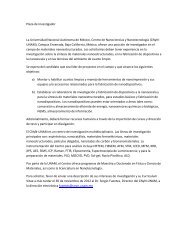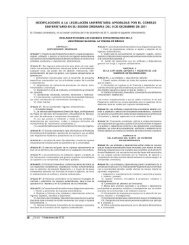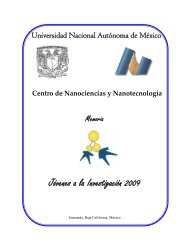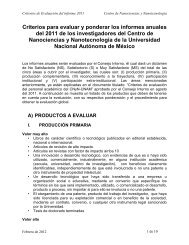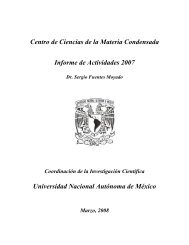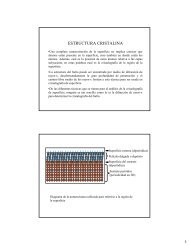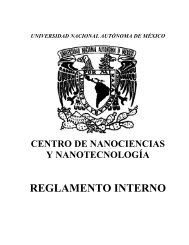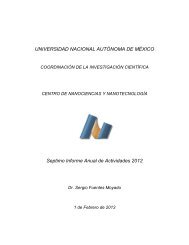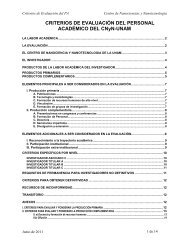Universidad Nacional Autónoma de México - CNyN
Universidad Nacional Autónoma de México - CNyN
Universidad Nacional Autónoma de México - CNyN
You also want an ePaper? Increase the reach of your titles
YUMPU automatically turns print PDFs into web optimized ePapers that Google loves.
1st International Symposium on Nanoscience and Nanomaterials<br />
PLENARY VI<br />
SOLID-VACUUM, SOLID-GAS AND SOLID-LIQUID INTERFACES: STRUCTURE AND<br />
DYNAMICS UNDER ENVIRONMENTALLY RELEVANT CONDITIONS<br />
Miquel Salmeron<br />
Lawrence Berkeley National Laboratory and Materials Science and Engineering Dept.<br />
University of California at Berkeley.<br />
New revolutionary technologies are nee<strong>de</strong>d to produce clean and renewable energies, efficient and<br />
highly selective chemical processes (green catalysis), high capacity rechargeable batteries, and fuel cells and<br />
also to find solutions to environmental problems. For this it is imperative to <strong>de</strong>velop new fundamental<br />
approaches to the study of the interface of solid materials with gases, liquids and solids, because it is in these<br />
environments that crucial processes occur that need to be un<strong>de</strong>rstood to enable revolutionary discoveries. One<br />
way to control the structure of interfaces and their properties is through the <strong>de</strong>sign of materials of nanoscale<br />
dimensions, with specific shapes, size and compositions. It is also imperative to use techniques that make<br />
possible in situ atomic level structural and spectroscopic characterization of interfaces. Today we are entering<br />
a new era of interface science and technology as a result of novel technical <strong>de</strong>velopments. The experimental<br />
results obtained so far with some of the newly <strong>de</strong>veloped techniques are very promising and <strong>de</strong>monstrate that<br />
the goal of control and examination of the nanoscale properties of interfaces is within reach. I will illustrate<br />
this with examples from research carried out in my laboratory, using scanning tunneling microscopy (STM),<br />
and new photoelectron and x-ray absorption spectroscopies (PES) un<strong>de</strong>r ambient conditions. Applications to<br />
catalyst mo<strong>de</strong>ls, in the form of thin films, single crystals and nanoparticles will be examined for applications<br />
in catalysis and electrochemistry.<br />
PLENARY VII<br />
CATALYSIS AND COMPLEXITY IN NANOTECHNOLOGY:<br />
FROM MECHANISM TO FUNCTION<br />
Valery V. Fokin<br />
1 The Scripps Research Institute, 10550 North Torrey Pines Road, La Jolla, California 92037, USA<br />
fokin@scripps.edu<br />
Keywords: catalysis, organic synthesis, <strong>de</strong>ndrimers, click chemistry<br />
Nanotechnology, as a molecular science, <strong>de</strong>pends on the efficient methods for controlled and<br />
<strong>de</strong>pendable assembly of complex molecular architectures. These molecular architectures store and transmit<br />
information and, therefore, have a <strong>de</strong>sired function. To succeed in this molecular construction en<strong>de</strong>avor, one<br />
requires exquisitely selective chemical transformations that can reliably introduce various functional groups<br />
in the product. Catalysis is at the heart of chemistry and disciplines that directly <strong>de</strong>pend on it, for harnessing<br />
the complexity of catalytic processes offers unprece<strong>de</strong>nted potential for making them useful on both<br />
laboratory and industrial scales. Catalytic activation of alkynes with transition metals will be the central<br />
theme of the lecture. Alkynes are among the most energetic hydrocarbons, and transition metals enable<br />
selective and controlled manipulation of the triple bond, opening the door to the wealth of reliable reactivity:<br />
transformations of alkynes into heterocycles and into a variety of molecules with new carbon–heteroatom<br />
bonds. The combination of catalytic alkyne functionalization followed by manipulation of the resulting<br />
4




